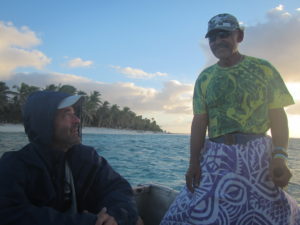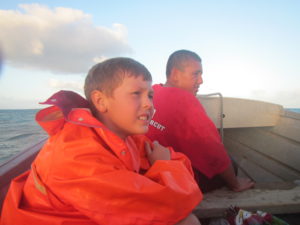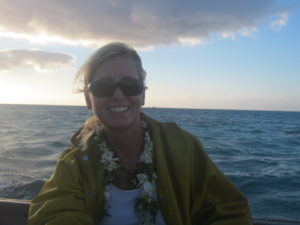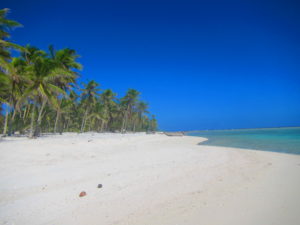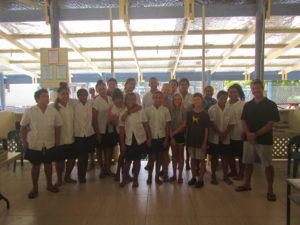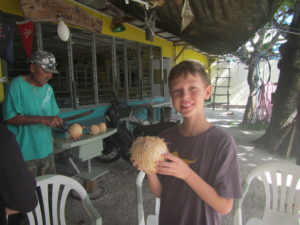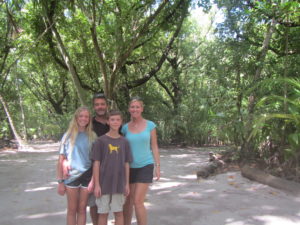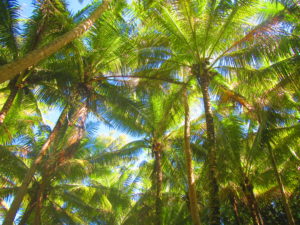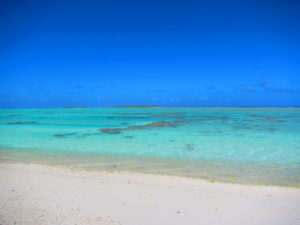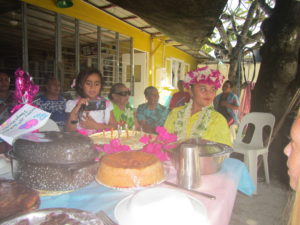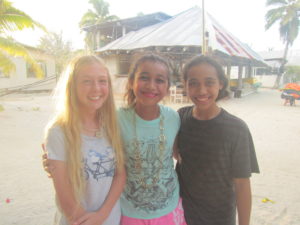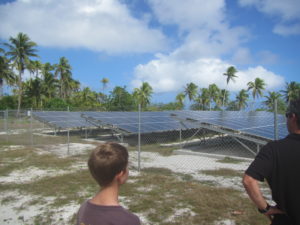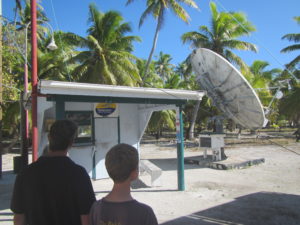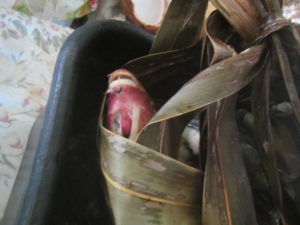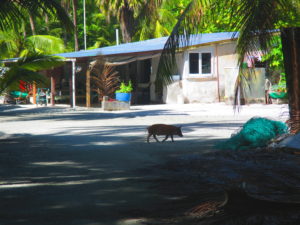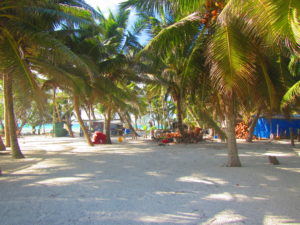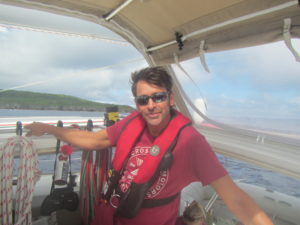Since we were not going to be able to go to Maupiti (because of our 90 day issue), we decided to stop at Palmerston Island on our way to Nuie. It was going to be a 4 night sail to Palmerston, and another three-night passage to Nuie. I was very much looking forward to Palmerston, which has an amazingly unique history. It is part of the Cook Islands, and therefore partially supported financially by New Zealand, but the residents are essentially all members of the Marsters family who settled on the island back in the mid 1800s.
Palmerston
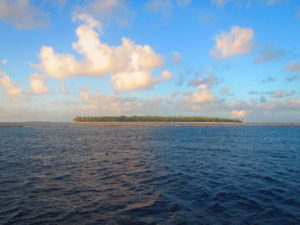
Heading to the Island
The Island
This is the description of Palmerston from Wikipedia:
“Overview[edit]
A true atoll, Palmerston Island consists of a number of sandy islets on a continuous ring of coral reef enclosing a lagoon. The largest of the islets include Palmerston, North Island, Lee To Us, Leicester, Primrose, Toms, and Cooks. The total land area of the islets is approximately 1 square mile (2.6 km2). The coral reef covers about 3,600 acres (15 km2). Thelagoon is some 7 miles (11 km) across, covering an area of 56 square kilometres (22 sq mi). There are several small passages through the reef for boats, though there is no safe entry for large ships. At a latitude of 18 degrees south, Palmerston enjoys a tropical climate but is exposed to severe tropical cyclones. A particularly destructive series of storms occurred during the 1920s and 1930s.
All the islets are wooded with coconut palms, pandanus, and native trees. There is some natural ground water on Palmerston but water captured from rainfall is preferred for drinking. Shellfish inhabit the reef, and fish are abundant although there are concerns about overfishing. There are only 62 people living in Palmerston,[3] all but three[3]descended from an Englishman named William Marsters (see History, below).
The economy is based on fishing, tourism, copra, and bird feathers, though Palmerston’s extreme remoteness makes a cash market difficult to maintain; in fact it is more like the subsistence ways of life in the northern atolls. Electricity and other modern utilities are available on the island. A recently built telephone station provides the only permanent link to the outside world. The island has no airport or regular air service, but cargo ships visit a few times a year.[3]
History[edit]
Palmerston was discovered by Captain Cook in 1774, but he did not land on the island until 13 April 1777. He found it uninhabited, though some ancient graves were discovered.[2] Cook named the island after Henry Temple, 2nd Viscount Palmerston, then Lord of the Admiralty.[2] The ancient name of the island was supposedly Avarau, meaning “two hundred harbour entrances”.[2] In 1863 William Marsters, a ship’s carpenter and barrel maker, arrived on Palmerston from Manuae with two Polynesian wives and annexed the island from the British government. He added a third wife and sired a large family of some 23 children, whose descendants now inhabit Palmerston. Thus, Palmerston Island is the only island in the Cook Islands for which English is the native language.
William Masters, originally thought to have come from Leicestershire, England, is now thought to have come from Gloucestershire, which might explain why his descendants now spell the name “Marsters” due to the Gloucestershire accent.[4] By the time his youngest daughter Titana Tangi died in 1973, there were over a thousand of Marsters’ descendants living in Rarotonga and New Zealand.
Though only some 50 family members remain on Palmerston, all of Marsters’ descendants consider the island their ancestral home. In 1954 the family was granted full ownership of the island. Three branches of the family remain on Palmerston, each branch being descended from one of William’s three wives,marriage within a family group being prohibited.[4] All of William’s wives came from Tongareva and there are still many family links and common ancestors between these atolls.”
Here is a bit more about William Marsters:
William Marsters
| William Marsters | |
|---|---|
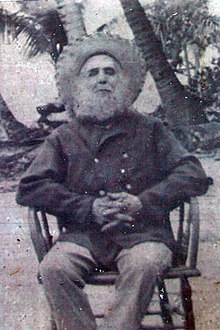
William Marsters on Palmerston Atoll
|
|
| Born | Richard William Masters 6 November 1831 Walcote, Leicestershire |
| Died | 22 May 1899 (aged 67) Palmerston Island, Cook Islands |
| Occupation | Sailor, cooper, merchant |
| Known for | English adventurer who settled on Palmerston Island in the Pacific |
William Marsters (born Richard Masters) (6 November 1831 – 22 May 1899) was an English adventurer fromWalcote, Leicestershire who settled on Palmerston Island in the Cook Islands on 8 July 1863, with his Polynesian wife and two Polynesian mistresses. A handful of his descendants continue to live on Palmerston Island, while the majority now live in Rarotonga, or elsewhere in the Cook Islands, New Zealand and Australia.
William Marsters was born Richard Masters in 1831. He originated from Leicestershire, England, and arrived in the Pacific around 1856. He first settled in Penrhyn, the most Northern of the Cook Islands. He married the daughter of one of the chiefs on the Island and in 1862 they moved to Manuae and then to Palmerston on 8 July 1863 (or 1861 or 1864 according to different documents[1]). They were accompanied by his wife’s cousin with whom he later had children. His task was to produce copra and collect bêche-de-mer for a Tahitian trader named Brander, but Brander never returned. William Marsters decided to settle his family permanently on the island. He took up a third wife, and the descendants of these three Penrhyn women make up the present inhabitants of Palmerston.[2] Marsters died on 22 May 1899 at the age of 67 (although his headstone records his age as 78). He had 23 children and 134 grandchildren.[3]
Ownership
In 1887, a Scotsman, George Darsie, contested an application by Marsters for a license to lease the island. Palmerston was annexed to the UK on 23 May 1891 and in 1892, the British Government granted William a 21-year lease which was extended until 1954.[4] Full ownership of Palmerston Atoll was granted to the Marsters family in 1954 by an amendment to the Cook Islands Act passed by the New Zealand Government.
Succession
Two years after William Marsters died, disputes arose about the succession of the leader. In 1901, Colonel Walter Edward Gudgeon, the British Resident in Rarotonga, appointed William’s eldest son, Joel, agent to the British Resident and Magistrate for the Island. In 1992 the Palmerston Act was passed, and today Palmerston is governed by this Act, along with the Outer Island Act.
Island Council
Before William Marsters died, he organized the island so that each of the three wives and their descendants had a share of the main island and each of the atolls. This arrangement still stands. Today the Island has its own council, representing the local government, which consists of six members, the Head of each Family – Matavia family, Akakaingaro family and the Te Pou family, and one other member appointed from and by each of the three families. This appointment is carried out every four years, and the Mayor of the Island is appointed from one of the three Heads, in a rotational manner.
On Palmerston, each of the three families has their own version of the history of Palmerston and life of William Marsters. This has been passed down by word of mouth from their great-great grandparents. Although oral tradition may differ from the documented versions, each will stand by their version.
Our Time on Palmerston
Their major export is Parrot Fish, although it doesn’t specifically mention that above.
When you go to Palmerston, one of the three families “hosts” you. We contacted Bill Marsters ahead of time via email and he told us to contact him via radio when we were close to arriving. Apparently, there is some competition among the families in hosting the yachties and he wanted to make sure he came to our boat first. Once we were moored and settled for a few hours, Bill (and Craig from New Zealand who was visiting Bill and his family on Palmerston for a few months), came back out to bring us to the island. We toured the island for a while, which included a visit to the school. We had brought some school supplies so we wanted to drop those off. While we we there, we met the students, the teachers (a married couple from the United States and South Africa who met in Korea), and the principal (who was from New Zealand). The kids actually do a Christian-based homeschool program and the teachers act as guides and help the kids when they need it. The kids had a break and Ari and Ryan got to play rugby with them for a little while. Then we went back to Bill’s place for a HUGE lunch and hung out there until early evening.
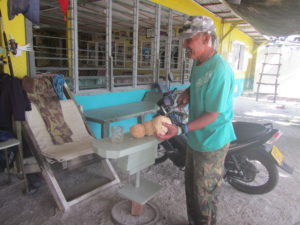
The next day, we came back to the island at around 10 in the morning. After school, Bill and his wife, Metua, were having a birthday party for their daughter, Julianna, who was turning 15. In the meantime, we went to the other side of the island where Dan, Ariana and Craig snorkeled and Ryan and I beach-combed. Ari said the water was very cold, but they did manage to see a shark and some pretty fish.
Later in the day, we attended Julianna’s birthday party, which was very fun and unique. Some of the kids dressed up (similar to Halloween) and we all ate traditional foods as well as some more recognizable to us Americans (e.g., Lasagna). We met so many of the folks who live on the island, and Bill supplied us with a great deal of food to take with us (e.g., coconuts, parrot fish, mayonnaise, a local chicken cooked traditionally, bread). They were so nice. What was fascinating was how much food the people on Palmerston stock in their freezers. Apparently, there are more freezers than people and they are full to the brim with food. I guess that is a result of not having any idea when another supply ship is going to come to the island; you end up hoarding food!
Solar Power on the Island
Telecommunications
Fish Head, Fish Head, Roly Poly Fish Head…
More Photos of the Island, Including the Roaming Pig
Interestingly, two sons of Tom Neale (who lived on the island of Suwarrow and wrote a book about it), reside in Palmerston. Arthur Neale asked us if we would be willing to take along Craig as crew since his 90 days were coming to an end in Palmerston and there were no supply ships expected to come to Palmerston anytime soon. So, we had a passenger/crew for our passage from Palmerston to Niue! Craig had been to the island several times before and had stayed in touch with Bill for years. Bill had to fly to NZ for his daughter, who was having unexplained seizures. Bill contacted Craig and asked if we wanted to come back with them and visit for a while. Craig did, and was on Palmerston for nearly three months. Those supply ships really ARE unpredictable and infrequent!
Craig was easy to have onboard and helped by cooking curry dinner and taking watches. He was trying to get home to Napier, New Zealand for his partner’s birthday. She was quite happy to hear he had gotten a ride and would be able to be home in time.
Our New Zealand Passenger/Crew/New Friend, Craig
I would write so much more about our time on Palmerston, but I can’t right now if I actually want to get this posted! It was a VERY worthwhile destination and I am so glad we went. Dan had thought it might be fairly cult-like on the island, but it was nothing like that at all. As you can imagine, being around your extended family all the time has its pros and cons, but most of the people were so nice and just living their lives like everyone else. What perhaps surprised me most was how “regular” the teenagers were. They had Facebook, dressed up sometimes, and acted just like American teens (for good or bad, ha ha!). What an experience!
